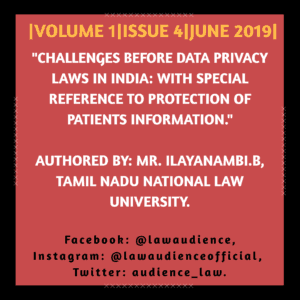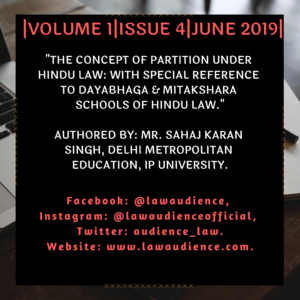Authored By: Ms. Manisha Nanda, Symbiosis Law School, Hyderabad.
I. ABSTRACT:
“This paper brings into spotlight the social issue of sexual abuses perpetrated by the priests of the Roman Catholic Church and the protection of such offenders by the religious institution which has been in practice since time immemorial. The victims, especially minor children have been physically, mentally and psychologically harassed by the priests who take undue advantage of their position to brainwash children into submitting themselves into activities, the consequences of which the minors do not understand owing to their tender age and immaturity. The paper discusses cases in India which have been brought to attention by the media which has, since the past decade, engaged in bringing to public attention the cases concerning sexual scandals and abuses perpetrated by the priests.
Moreover, the paper attempts to address the general perspective and the reception of such scandals by the general public and the believers. Additionally, the paper highlights the challenges that the religious institution faces in addressing the matters reported to it. The paper is concluded by putting forth a series of recommendations and suggestions that can be undertaken by the religious institution to effectively protect the institution without harbouring the offenders.”
Keywords: Roman Catholic Church, Sex abuse, minors, media, priests.
II. INTRODUCTION:
The physical, mental and psychological consequences of sexual trauma are generally extremely traumatic, serious and enduring when the sexual predator is an acquaintance who of the victim/survivor.[1] For many of us, religion and spirituality form a substantial part of the lives from which we derive meaning globally.[2] It comprises a system which is imbibed with a magnitude of hope, optimism and is entrenched within which is a coping mechanism. Religion and spirituality provide a platform, from which people derive a meaning to shape their lives drastically and are regarded as popular coping strategies as they may contribute to greater resilience, support and guidance. Moreover, for many people, religion and spirituality symbolise purity, freedom and a place of refuge and safety.[3] However, traumatic events perpetrated by the institution or the agents of the institution can substantially shake this foundation of belief, assumption and trust to such an extent that people are left shattered, grief-stricken and lost. For centuries altogether now, sexual abuse has existed in the Roman Catholic Church, dating at least as far back as to the 11th century.[4] However, more than often these cases have been subdued by the Church by using soft methods of coercion in the name of God. These sexual abuse scandals have gathered the attention of the media and the general public in the United States, Canada, United Kingdom, Belgium, France, Ireland, Australia and Germany. Nevertheless, cases of sexual abuse have also been reported in other nations as well on a global scale.[5] A majority of these cases have been brought to light only after a significant amount of time has passed since its occurrence.
III. IMPORTANCE/SIGNIFICANCE OF THE STUDY:
Incidents of sexual abuse by the priests of the Roman Catholic Church have been prevalent since centuries altogether but have hardly been in the spotlight due to the taboo associated with it. However, in the 20th and the 21st centuries due to the attention drawn to the issue by the media, cases of such violations have surfaced and have led to a multitude of allegations, arrests, investigations, proceedings, and convictions as well as the revelations regarding decades of suppression by the Church to cover up such incidents. This study attempts to highlight the key social issue with the help of multiple case studies in India and seeks to garner attention towards the sensitivity, magnitude and the intensity of the matter.
IV. RESEARCH QUESTIONS:
- Has the proliferation of the issue of sexual abuse committed by the priests of the Roman Catholic Church in other countries shed some light on the similar cases that are uncovered in India?
- Can any steps be taken to address the issue of sexual abuse by religious institutions apart from implementing legislations?
V. LIMITATIONS OF THE STUDY:
This paper focuses only on one of the major religions in the world with respect to the sexual offences committed by the priests of the Roman Catholic Church. However, the research is not, in any way, conclusive of the fact that sexual abuse by other religious institutions is not prevalent. The research only focuses on one major religion for the purpose of thorough research and analysis.
VI. RESEARCH METHODOLOGY:
The paper is based on data which is secondary in nature. Moreover, secondary sources of data include websites, reports and journals, etc. but are not restricted to the same. Additionally, the above-stated approach is a general explanation in terms of the approach adopted.
VII. ANALYSIS:
In India, as stated by Mathew N. Schmalz in 2002, Catholic Church sexual abuse scandals are not generally even spoken about and that there are gossips and rumours, but it never reaches a level wherein formal changes and controversies can unveil.[6]
Kerala has been witnessing a surge in the number of cases reported of sexual abuse by priests of the Church against minors in the past decade. 2014 saw the arrest of the vicar of the Saint Paul’s Church in Thaikkattussery in Kerala who was arrested on charges of having raped a nine-year-old girl. Having promised her new clothes for her Holy Communion ceremony in the Church, the priest indulged in abusing her instead and was thereafter booked under Section 376 of the Indian Penal Code and POCSO when the matter came to the knowledge of her parents.[7]
In 2017, the parish priest at Puthenvelikkara was given double life imprisonment under POCSO for having being convicted in the case of the rap of a 14 year-old-girl. He was also charged with a fine of 2.5 Lakhs rupees and the court held that the jail sentence will run concurrently. Moreover, the priest’s brother was also charged with a sentence of one year for having assisted the convict in going into hiding after the police case had been registered. According to the prosecution, the priest had raped the minor victim on multiple occasions on the pretext of music classes while he was serving as the priest in the Church, until she disclosed the incidents to her mother in January 2015. [8]
The same year saw the arrest of yet another Catholic priest from Kerala who was charged with the sexual assault of a seminarian under sections 377, 342 and 506 (II) r/w 34 of the Indian Penal Code. The priest was alleged to have forced himself into the room of the victim who was studying for priesthood and subject himself to unnatural sex. According to the complaint, when the student tried to resist, the priest would threaten and mentally harass him.[9]
The Catholic Church isn’t unaware of the incidents surrounding its priests indulging in gross sexual abuses, especially of the practice of paedophilia predominant in the priests. However, the most shocking wave hits us when we come to know of cases wherein the Church was well aware of the actions of its agents yet, no stringent mechanism was undertaken to prevent and/ punish the offender.
In this regard, light can be shed upon the South Indian Catholic Church Case of 2005 wherein the Indian priest hailing from Tamil Nadu was convicted in the Minnesota Court for having sexually abused a minor and was sentenced to a one-year prison term.[10] After serving a shorter prison term on a plea bargain with the condition to never resume ministerial duties and come in contact with children, he returned to India. As a shock to the child rights activists in the State, the Roman Catholic Church of Southern India lifted the suspension imposed on him. By welcoming the former priest back into the Church, it had blatantly disregarded the viewpoint of the Catholic Bishops’ Conference in India in 2010 which had stated to have a zero-tolerance policy to the abuse of children in the institutions run by the Church. This re-appointment not only cost the previous victims mental harassment but this brought with itself little regard for the safety and jeopardised the protection of victim rights and children’s safety.
The most discussed case in the context of sexual abuse of Church is the Kerala Nun Rape Case which challenged the entire faith of Christianity.[11] In 2018, a senior nun alleged rape by a Bishop, who was the head of the Latin diocese of Jalandhar. She alleged that she had been sexually assaulted by him multiple times since 2014 at the Church guest house of Kuruvilangad. When she had approached the Church hierarchy to complain about the same, her pleas were flagrantly disregarded by the authorities, after which she went to the police. In the light of this case, the whole country was put into a conundrum as to whether to believe the victim or not considering that matters like these were not spoken of in public and more than anything, it was not just a question of modesty, it was a question on faith and hence the conflict of opinion. The matter gained momentum when fellow nuns of the victim took to the streets and staged protests calling out the male hegemony that existed in the institution and asked for the bishop to be removed from his position and be reprimanded for his actions. The nuns who were protesting also said that they knew of many cases wherein the church authorities were well aware of the abuses but were silent spectators and did nothing about it. The nuns had also written to the Vatican about the issue without having received any response from them. Only after two months of protests was the accused arrested but was released on bail later and was welcomed back into the Church at his hometown who threw a ‘welcome back’ party for him. [12]
The challenge in cases of sexual abuse by the priests is that it shakes the foundation of belief and trust that is entrusted in the institution and hence people who fail to muster the mental strength to accept the fact that the charade of this entrusted protection can also be misused by the agents of the protector itself. Believers tend to justify the actions of these predators by arguing that the perpetrator’s actions can be excused considering that he holds the position of a religious head of their institution and hence can be excused from his sins.
The façade of faith inevitably masks their perceptions, clouds their judgment and makes them immune from feeling remorse in the form of apathy or sympathy for the victims. The disbelief and the sheer fear of subjecting the institution to taint of any kind becomes a matter of priority when weighed against seeking justice for a person who has been subject to the taint brought in by the institution itself.
VIII. CONCLUSION:
In recent times, the promotion of public discussions and debates revolving around sensitive topics, have in turn fostered the unveiling of the topic of sexual abuse, especially of minors and women in religious institutions. This discourse has paved the way for the disclosure of incidents which have led our legal systems to be more inclusive in terms of protecting the rights of children and women altogether. Various stringent laws have in fact come into force following gross abuses of the rights of children. However, the success of these legislations in apprehending the guilty, depend invariably on the unveiling of the offences committed. This can happen only when instead of extending protection to the accused by the religious institution, proactive countermeasures and steps are taken in this regard to reprimand and punish the guilty. It has to be understood that the foundation of a religious institution is not based upon the status of its priests; rather it is based on the holistic protection of the faith and the beliefs that are entrusted to the institution itself. From the perspective of the religious institution, it can be gathered that a religious institution hesitates, more than often, to call out an offender who serves as an agent to the Church. This scepticism emanates from the fear that doing so will bring with itself a downpour of questions, distrust, taint and irreparable damage to the institution and hence, matters of significant sensitivity are supressed time and again with plain indifference served to the victim on an empty plate.
What is of paramount importance is to understand that the fact that with growing attention of the media and spotlight on these issues in the current era of information, the overpowering suppression of these issues cannot hold ground. When uncovered, these issues will culminate into a single storm which will destroy not only the institution but also the people who have unflinchingly harboured their faith in the institution for time immemorial.
In conclusion, it is now pertinent that the eye of the storm has been formed and it is gaining momentum successfully. It is safe to say that, the winds of the storm have picked up and in another few years, we will not be able to ignore its rage.
IX. SUGGESTIONS/RECOMMENDATIONS:
Hence, in the light of this, the mitigating steps which can be taken by the religious institutions are as follows:
- Firstly, to accept that their agents are more than capable of committing gross violations of rights by sexually abusing minors and women by influencing and brainwashing them.
- Secondly, instead of protecting these offenders, measures to protect the foundation of faith should be taken. This will be possible pragmatically when the Church itself encourages its believers who have been subjected to any kind of abuse by the agents of the Church. When the victims come out with their traumas and complains, the Church could investigate and report the matter to the police for further investigation instead of harbouring the offender in the premises or transferring him to a different Church to continue his abuse journey.
- Thirdly, proper surveillance mechanisms should also be put into place in the premises of the Church and the surroundings to keep a stringent check on the offences committed. Awareness has to be disseminated and people need to change their outlook towards the reception of this issue and the zero-tolerance policy needs to be implemented strictly to bring about essential, fundamental changes in the institution.
- Lastly, rehabilitation of the victims is pivotal in order to save them from slipping into even more trauma psychologically over time.
The mental equation and perspective of the religious institution, the believers and the society have to undergo substantial changes if they are to become receptive to this age-old social issue which requires immediate attention and elimination.
Bibliography:
- Why has South India’s Catholic Church re-inducted a convicted child molester priest. (2016). Retrieved from The News Minute: https://www.thenewsminute.com/article/why-has-south-india%E2%80%99s-catholic-church-re-inducted-convicted-child-molester-priest-39078
- Minor Abuse bypriests turning into a major issue for catholic Church in Kerala. (2017). Retrieved from The New Indian Express: http://www.newindianexpress.com/states/kerala/2017/mar/01/minor-abuse-by-priests-turning-a-major-issue-for-catholic-church-in-kerala-1575987.html
- Looking Back: The Kerala Nun Rape Case That Challenged an Entire Faith. (2018). Retrieved from News 18: https://www.news18.com/news/india/looking-back-the-kerala-nun-rape-case-that-challenged-an-entire-faith-1983831.html
- Abraham, B. (n.d.). Kerala Catholic Priest Gets Double Life Sentence For Rape Of Minor Girl . Retrieved from https://www.indiatimes.com/news/india/kerala-catholic-priest-gets-double-life-sentence-for-rape-of-minor-girl-267028.html.
- Berger P., L. T. ((1966)). The Social construction of reality. New York: Penguin Books.
- Catholic Church sexual abuse cases. (n.d.). Retrieved from Wikipedia: https://en.wikipedia.org/wiki/Catholic_Church_sexual_abuse_cases#India
- Catholic priest held for sexually assaulting student in Kerala. (n.d.). Retrieved from Indian Express: https://indianexpress.com/article/india/india-news-india/catholic-priest-held-for-sexually-assaulting-student-in-kerala-3104655/
- Falsetti S. A., R. P. ((2003) ). Changes in religious beliefs following trauma. Journal of Traumatic Stress, 391–398.
- Integration of sexual trauma in a religious narrative: Transformation, resolution and growth among contemplative nuns. (n.d.). Retrieved from Ncbi: https://www.ncbi.nlm.nih.gov/pmc/articles/PMC4107816/
- Paulson, M. (2002, August 4). World doesn’t share US view of scandal. Retrieved from The Boston Globe: http://archive.boston.com/globe/spotlight/abuse/print/040802_world.htm
- Priest booked for rape of minor. (n.d.). Retrieved from Deccanhelad: https://www.deccanherald.com/content/402380/priest-booked-rape-minor.html.
[1]Glòria Durà-Vilà and Roland Littlewood, Integration of sexual trauma in a religious narrative: Transformation, resolution and growth among contemplative nuns, Transcultural Psychiatry, (March 3, 2019, 3:00 P.M) available at https://www.ncbi.nlm.nih.gov/pmc/articles/PMC4107816/.
[2] Berger P., Luckman T. (1966) The Social construction of reality, New York, NY: Doubleday.
[3] Falsetti S. A., Resick P. A., Davis J. L. (2003) Changes in religious beliefs following trauma. Journal of Traumatic Stress, 16 at pg. 391–398.
[4]Catholic Church Sexual Abuse Cases, (March 3 , 4:00 P.M) available at https://en.wikipedia.org/wiki/Catholic_Church_sexual_abuse_cases#India.
[5] Paulson, Michael (8 April 2002), World doesn’t share US view of scandal: Clergy sexual abuse reaches far, receives an uneven focus The Boston Globe.
[6]Catholic Church Sexual Abuse Cases, (March 3, 2019, 4:00 P.M) available at https://en.wikipedia.org/wiki/Catholic_Church_sexual_abuse_cases#India.
[7]Deccan Herald, Priest booked for rape of minor (March 3, 2019, 5:00 P.M) available at https://www.deccanherald.com/content/402380/priest-booked-rape-minor.html ; The New Indian Express, Minor abuse by priests turning a major issue for Catholic Church in Kerala, (March 3, 2019 8:00 P.M) available at http://www.newindianexpress.com/states/kerala/2017/mar/01/minor-abuse-by-priests-turning-a-major-issue-for-catholic-church-in-kerala-1575987.html.
[8] Bobins Abraham, Kerala Catholic Priest Gets Double Life Sentence For Rape Of Minor Girl (March 2, 2019, 3:00 P.M) available at https://www.indiatimes.com/news/india/kerala-catholic-priest-gets-double-life-sentence-for-rape-of-minor-girl-267028.html.
[9]Shaju Philip, Catholic Priest held for sexually assaulting student in Kerala (March 2, 2019, 8:00 PM) available at https://indianexpress.com/article/india/india-news-india/catholic-priest-held-for-sexually-assaulting-student-in-kerala-3104655/.
[10] Dhanya Rajendran, Why has South India’s Catholic Church re-inducted a convicted child molestor priest? (March 1, 2019, 3:00 P.M) available at https://www.thenewsminute.com/article/why-has-south-india%E2%80%99s-catholic-church-re-inducted-convicted-child-molester-priest-39078.
[11]Aishwarya Kumar, Looking Back:The Kerala Nun Rape Case that Challenged an Entire faith (March 1, 2019, 5:00 P.M) available at https://www.news18.com/news/india/looking-back-the-kerala-nun-rape-case-that-challenged-an-entire-faith-1983831.html.
[12] Ibid.



